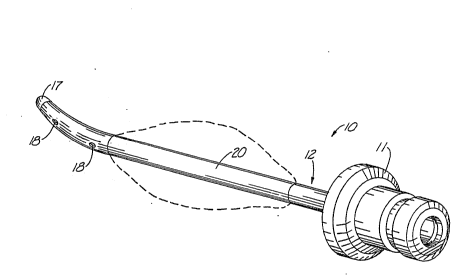Some of the information on this Web page has been provided by external sources. The Government of Canada is not responsible for the accuracy, reliability or currency of the information supplied by external sources. Users wishing to rely upon this information should consult directly with the source of the information. Content provided by external sources is not subject to official languages, privacy and accessibility requirements.
Any discrepancies in the text and image of the Claims and Abstract are due to differing posting times. Text of the Claims and Abstract are posted:
| (12) Patent: | (11) CA 1313803 |
|---|---|
| (21) Application Number: | 605549 |
| (54) English Title: | SINGLE CHANNEL BALLOON UTERINE INJECTOR |
| (54) French Title: | DISPOSITIF D'INJECTION UTERINE AVEC TUBE GONFLABLE ET CANAL UNIQUE |
| Status: | Deemed expired |
| (52) Canadian Patent Classification (CPC): |
|
|---|---|
| (51) International Patent Classification (IPC): |
|
| (72) Inventors : |
|
| (73) Owners : |
|
| (71) Applicants : | |
| (74) Agent: | |
| (74) Associate agent: | |
| (45) Issued: | 1993-02-23 |
| (22) Filed Date: | 1989-07-13 |
| Availability of licence: | N/A |
| (25) Language of filing: | English |
| Patent Cooperation Treaty (PCT): | No |
|---|
| (30) Application Priority Data: | None |
|---|
-9-
Abstract of the Disclosure
An apparatus for injection of dye or contrast
medium into a uterine cavity. An elongated member
having a first and a second end and an intermediate
portion has a liquid impervious expandable tube
disposed around it and is sealed on each end thereof to
the exterior thereof. A first fluid passageway extends
from one end of the elongated member to a barrier and
another fluid passageway extends from the other end of
the elongated member to the barrier. A first opening
in the elongated member allows fluid communication
between the first passageway and the inside of the
balloon tube and a second opening in the elongated
member provides fluid communication between the second
fluid passageway and the inside of the balloon tube.
The second opening is substantially smaller in
cross-sectional area than the first opening whereby
fluid pressure applied to the first passageway will
remain substantially higher than the pressure in the
second fluid communication passageway, whereby fluid
pressure within the tube will cause it to expand to
seal against the inner wall of the uterine cavity,
while at the same time fluid will flow sequentially
from the first fluid communication passageway, through
the first opening, through the expanded balloon tube,
through the second opening, through the second
communication passageway and out through a discharge
opening structure on one end of the second fluid
communication passageway.
Note: Claims are shown in the official language in which they were submitted.
Note: Descriptions are shown in the official language in which they were submitted.

For a clearer understanding of the status of the application/patent presented on this page, the site Disclaimer , as well as the definitions for Patent , Administrative Status , Maintenance Fee and Payment History should be consulted.
| Title | Date |
|---|---|
| Forecasted Issue Date | 1993-02-23 |
| (22) Filed | 1989-07-13 |
| (45) Issued | 1993-02-23 |
| Deemed Expired | 2002-02-25 |
There is no abandonment history.
| Fee Type | Anniversary Year | Due Date | Amount Paid | Paid Date |
|---|---|---|---|---|
| Application Fee | $0.00 | 1989-07-13 | ||
| Maintenance Fee - Patent - Old Act | 2 | 1995-02-23 | $50.00 | 1995-04-18 |
| Maintenance Fee - Patent - Old Act | 3 | 1996-02-23 | $50.00 | 1995-12-08 |
| Maintenance Fee - Patent - Old Act | 4 | 1997-02-24 | $250.00 | 1997-12-30 |
| Maintenance Fee - Patent - Old Act | 5 | 1998-02-23 | $75.00 | 1997-12-30 |
| Maintenance Fee - Patent - Old Act | 6 | 1999-02-23 | $75.00 | 1998-12-10 |
| Maintenance Fee - Patent - Old Act | 7 | 2000-02-23 | $75.00 | 1999-01-20 |
Note: Records showing the ownership history in alphabetical order.
| Current Owners on Record |
|---|
| VALTCHEV, KONSTANTIN LAZAROV |
| Past Owners on Record |
|---|
| None |